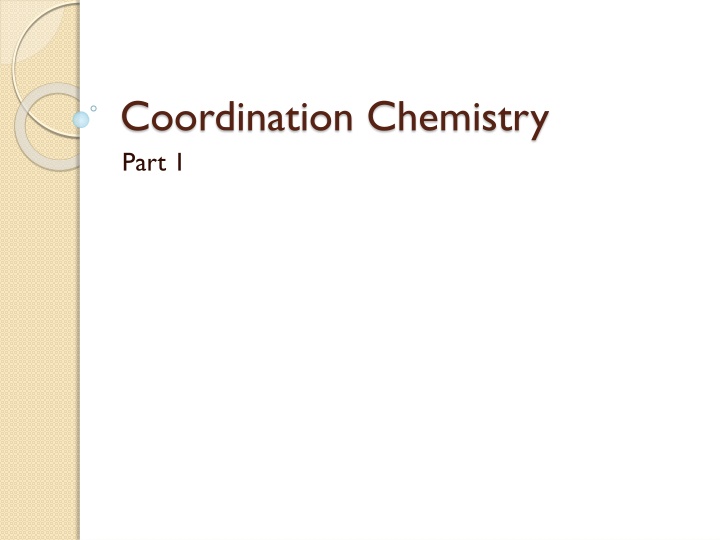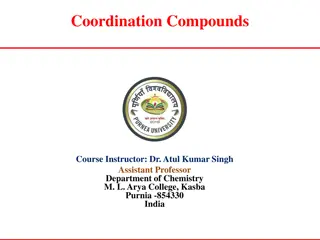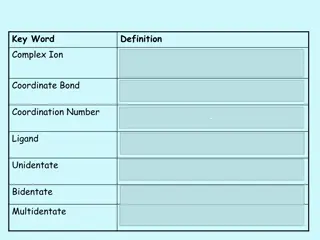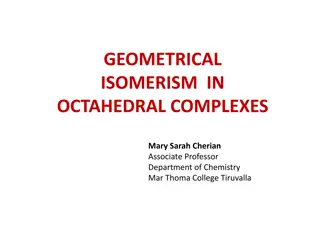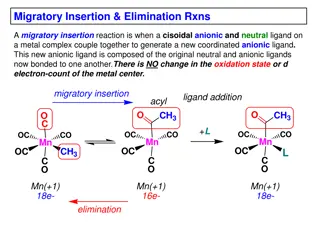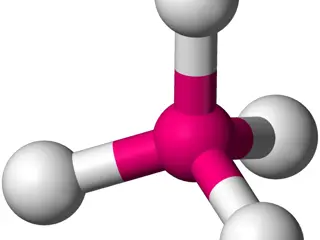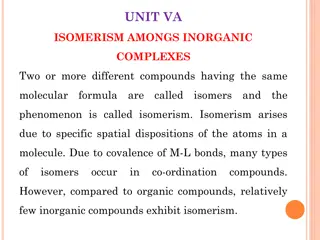Insights into Coordination Chemistry Elements and Complexes
Transition elements with d or f electrons possess unique properties, play crucial roles in biological processes, and form colorful complexes with ligands. Occurring widely in nature, these elements have varied oxidation states and coordination numbers. Werner's formulation sheds light on primary and secondary valencies in complex formation. Lewis model illustrates the interaction between central metal ions and ligands in a covalent manner. The study of these elements enhances our understanding of chemical bonding and coordination compounds.
Download Presentation

Please find below an Image/Link to download the presentation.
The content on the website is provided AS IS for your information and personal use only. It may not be sold, licensed, or shared on other websites without obtaining consent from the author.If you encounter any issues during the download, it is possible that the publisher has removed the file from their server.
You are allowed to download the files provided on this website for personal or commercial use, subject to the condition that they are used lawfully. All files are the property of their respective owners.
The content on the website is provided AS IS for your information and personal use only. It may not be sold, licensed, or shared on other websites without obtaining consent from the author.
E N D
Presentation Transcript
Coordination Chemistry Part 1
Transition Elements Possessing properties transitional from one row to the next Elements with d or f electrons d-block elements or d-block metals
Occurrence Wide distribution throughout crust and oceans First row d-block elements higher in the human body than in ocean water Mammalian biochemical importance of iron Molybdenum is required for life
Color Yellow Purple Green Formula CoCl3 6NH3Luteocobaltic chloride CoCl3 5NH3Purpurocobaltic chloride CoCl3 4NH3Praseocobaltic chloride Name
Hemoglobin porphyrin
Vitamin B12 cyanocobalamin
Observations Deep blue CoCl2 turn red in solution Green black FeCl3 turn yellow Golden yellow NiBr2 turn green Evaporation of the respective solutions give CoCl2 6H2O FeCl3 6H2O NiBr2 6H2O
Complexes Werner s formulation CoCl3 6NH3 CoCl3 5NH3 CoCl3 4NH3 CoCl3 4NH3 Current formulation [Co(NH3)6]Cl3 [Co(NH3)5]Cl3 [Co(NH3)4]Cl3 [Co(NH3)4]Cl3 Color Original name Yellow Purple Violet Green Luteocobaltic chloride Purpureocobaltic chloride Violeocobaltic chloride Praseocobaltic chloride CoCl3 6NH3 + Ag+ 3AgCl Primary and secondary valencies CoCl3 5NH3 + Ag+ 2AgCl Oxidation and coordination numbers CoCl3 4NH3 + Ag+ 1AgCl
Six-coordinate Isomers Formula Octahedral Prism Hexagonal MX5Y MX4Y2 MX3Y3 1 2 2 1 3 4 1 3 3
Lewis Model Central metal ion or atom surrounded by a set of ions or molecules (ligands) 2-electron coordinate covalent (dative) interaction Ligands must possess lone pairs :NH3 + BF3 H3N BF3 (Lewis acid-base adduct)
Lewis Model M Does not explain magnetic data nor electronic spectra L
Ligands Attached to the metal via one atom (donor atom) Monatomic or polyatomic ions, neutral molecules, -bonds (resulting in C2M units) (* catalytic activation of alkenes by d-block metals or compounds) atoms with more than one electron pair sometimes form two bonds with metal centers (bridging)
Ligand Names Water: aqua , Ammonia, ammine , Carbon monoxide bonded via carbon: "carbonyl , Nitrogen monoxide bonded via nitrogen: "nitrosyl anion with name ending in ide is changed to end in o anion names ending in -ite, -ate are named as ligands by changing to -ito, -ato
Ambidentate ligands bond to a metal center through more than one kind of atom
Polydentate ligands Ligands with more than one atom with lone pairs can bind to the metal through both atoms (or more) Donor Atoms 2 3 4 5 6 Name Didentate Tridentate Tetradentate Pentadentate Hexadentate
Chelate A metal bound to polydentate ligands forms a ring system containing the metal
Bridging ligands ligand that connects two or more metal atoms (ions).
Macrocyclic ligands Rings at least nine atoms large with at least three donor atoms for stable complexes with transition metals
Pi systems Double bonds in polyalkenes are capable of binding to metals just like lone pairs with each bond occupying a coordination site (6-coordinate Fe in ferrocene)
Nomenclature The name of the positive ion is written before the name of the negative ion. The name of the ligand is written before the name of the metal to which it is coordinated.
Nomenclature The names of negative ligands always end in o, as in fluoro (F-), chloro (Cl-), bromo (Br-), iodo (I-), oxo (O2-), hydroxo (OH-), and cyano (CN-). A handful of neutral ligands are given common names, such as aqua (H2O), ammine (NH3), and carbonyl (CO).
Nomenclature The Greek prefixes mono-, di-, tri-, tetra-, penta-, hexa-, and so on are used to indicate the number of ligands when these ligands are relatively simple. The Greek prefixes bis-, tris-, and tetrakis- are used with more complicated ligands.
Nomenclature Ligands are listed in alphabetical order. The oxidation number of the metal atom is indicated by a Roman numeral in parentheses after the name of the metal atom.
Nomenclature The names of complexes with a net negative charge end in -ate. Co(SCN)42-, for example, is the tetrathiocyanatocobaltate(II) ion. When the symbol for the metal is derived from its Latin name, -ate is added to the Latin name of the metal. Thus, negatively charged iron complexes are ferrates and negatively charged copper complexes are cuprates.
[Cr(OH)4]- complex is an anion There is only one monodentate ligand, hydroxide. There are four of them, so we will use the name "tetrahydroxo The metal is Chromium, but since the complex is an anion, we will have to use chromate The oxidation state of the metal is 3, therefore, this coordination complex is called tetrahydroxochromate (III)
[CuCl4]2- Tetrachlorocuprate (II)
[Pt(NH3)4)][Pt(Cl)4] NH3 is neutral, and Cl has -1 charge. Therefore, you will write the complex with NH3 first, then Cl last. coordination compound is called tetraammineplatinum (II) tetrachloroplatinate (II)
Practice set [Cr(NH3)3(H2O)3]Cl3 [Pt(NH3)5Cl]Br3 [Pt(H2NCH2CH2NH2)2Cl2]Cl2 Co(H2NCH2CH2NH2)3]2(SO4)3 K4[Fe(CN)6] Na2[NiCl4] Pt(NH3)2Cl4 Fe(CO)5
Stability constants Stepwise substitutions of complexed water Equilibrium processes with respective equilibrium constants Overall equilibrium constant is called stability constant or formation constant M ML = = n K K K K K n 1 2 3 n L
Factors affecting structure 1. Number of bonds (exothermic bond formation) 2. VSEPR (simpler cases of main groups) 3. Occupancy of d orbitals (tetrahedral vs square planar) 4. Steric interferences of large ligands 5. Crystal packing effects in solids (sizes of ions and complexes may lead to distortions)
Low Coordination CN 1 is rare, except in ion pairs in the gas phase Tl(I) and In(I) complexes of 2,6-Trip2C6H3
Low Coordination CN 2 is also rare [Ag(NH3)2+] with the d10 Ag+ ion (spherical) [CuCl2]-, Hg(CN)2, [Au(CN)2]-
Low Coordination CN 3 is also more likely with d10 ions with trigonal planar structure most common [Au(PPh3)3]+ where bulky ligands prevent larger coordination numbers All first row transition metals except Mn(III) either with 3 identical ligands or two of one ligand and one of the other MnO3+, HgI3-, [Cu(SPMe3)Cl]3
NBu4[Cu(CN)2] Anion has chain-like structure with the Cu trigonally coordinated Ligands bridge two metals Danger of extrapolating solid state coordination from stoichiometry C N Cu C C N C N Cu C N Cu N C C C N N Cu C N Cu C C N N N C Cu C N
Coordination Number 4 Smallest common coordination Tetrahedral and square planar (with intermediate and distorted geometries) d8 metals are square planar Steric effects from small metal or large ligands compensate for the advantage of forming more M-L bonds
O O C C Cl Cl Rh Rh Rh C RhCl(CO)2 C O O O C Rh Cl RhC Rh Cl C O O C O C C C C C C N C C C N Cu S C C S C C C 2-pyridylmethylbis(2-ethylthioethyl)amine
Coordination Number 5 Trigonal bipyramidal and square pyramidal Marginal energy difference between the two allow for easy intercoversion Intermediate geometries Ligands exchange between sites in fluxional compounds
[Fe(CO)4(PPh3)] P OC Fe CO OC CO [Co(CNPh)5](ClO4)2 N N C C N C Co C N C N
Coordination Number 6 Most common coordination number Octahedral geometry, but also occasionally trigonal prismatic (d0) [Re{S3(CH2)3CMe}2]+ SS S Re SS S
Higher Coordination Less common Ligand-ligand interactions become more important so smaller ligands allow these coordination numbers
Capped octahedron Pentagonal bipyramid Capped trigonal prism Dodecahedron Square antiprism Tricapped trigonal prism
